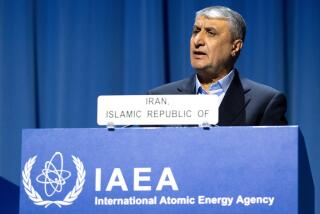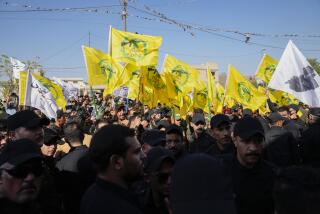Whatâs wrong with the Iranian army? Deadly shootings put spotlight on forced military service
Reporting from Tehran â One night last year at an army barracks in Tehran, a tormented young conscript rousted his sergeant from bed and marched him outside at gunpoint.
The private made his superior writhe in the dirt for an hour, mimicking the exercises he had been forced to do for two months after he was drafted. The private would soon disappear; soldiers later heard he was imprisoned for three years.
Ahmad, a 25-year-old draftee who had just reported to the base, recalled that incident this summer after a series of deadly shootings by conscripts focused national attention on the struggles faced by those completing Iranâs mandatory military service.
âI sympathize with the shooters,â said Ahmad, who like several recruits interviewed for this story requested that his last name be withheld because he could be punished for speaking out. âSomething or someone must have been torturing them so deeply. Thatâs why they did what they did.â
I hate the service and I hate my surroundings. I donât feel any patriotism in my heart.
— â Ahmad, 25-year-old Iranian conscript
In July, a 23-year-old draftee holed up in his room at a barracks in southern Iran with a loaded weapon after his superiors turned down his request for leave. He shot and wounded a police officer before killing himself.
A soldier in northern Iran who was denied a transfer to another base opened fire on service members, killing three and injuring six. The shooter was hospitalized.
In August, a conscript from the countryâs poorest province gunned down three troops at a garrison in Tehran and wounded at least eight others before he was shot. He died on the way to the hospital.
Reports of trouble inside Iranâs secretive security forces are rare. While scant details have emerged from officials or state media, many young draftees said the violence was not surprising.
They described Iranâs military training as a 21-month ordeal of physical humiliation, psychological stress and petty corruption, where mental health problems fester and socioeconomic grievances are magnified. Many said superiors often trample on poor and disadvantaged recruits while the wealthy and well-connected avoid the toughest tasks â or dodge the draft altogether.
âAlmost everyone is a victim of hazing and mistreatment,â Ahmad said. âI am educated, so I donât have it as bad. But I hate the service and I hate my surroundings. I donât feel any patriotism in my heart.â
The shootings have raised uncomfortable questions for Iranâs army, one of the largest in the Middle East with an estimated 350,000 active-duty troops, nearly two-thirds of whom are conscripts.
Although far less powerful or well financed than the elite Islamic Revolutionary Guard Corps â whose commanders hold stakes in key industries and lead Iranâs military adventures in foreign landsâ the nationâs conventional army, or artesh, a mainly defensive force, has long been seen as a pillar of the Islamic Revolution at home and loyal servants of the theocracy.
But a prolonged economic crisis and growing resentment of clericsâ sweeping powers have dampened Iraniansâ revolutionary zeal.
The recruits entering the army now were all born after the 1979 revolution. Experts say the shootings signal a young generationâs increasing hostility to a ruling class that controls what they watch, wear, read and eat, and its worries about an economy that has failed to rebound despite the promises of the 2015 nuclear agreement, which relaxed international sanctions on Iran.
âWhen you see things like this in the garrison, itâs a reflection of the broader problems in society,â said Misagh Parsa, a sociology professor at Dartmouth College and author of âDemocracy in Iran: Why It Failed and How It Might Succeed.â
âThe draftees, almost all of them, they know their future is bleak. Theyâre sacrificing two years of their lives, but for what? They are more agitated than previous generations because of all the social and economic failures and the absence of better alternatives.â
Iran, among roughly 60 countries that use a draft system, began conscription almost a century ago under the former monarchy. (Women were included until 1979, when the new Islamic rulers began enforcing segregation of the sexes.) Service is mandatory for all males older than 18, although some wealthy families are able to pay fines to keep their children out of the draft, so in practice the poorest Iranians are overrepresented in the forces.
Military service begins with two months of physical training, in which recruits wake before dawn six days a week for frog jumps and other exercises, and education in weapons, self-defense and responding to chemical attacks. Then they are assigned to up to 19 months of active duty.
Uneducated soldiers are often sent to guard remote outposts, while those with connections can often negotiate undemanding desk jobs. Those disparities are in the spotlight now because they appeared to have been a factor in both July shootings.
Ahmad, the draftee from Tehran, sorts and distributes mail for a senior commander, a job he got because his brother-in-law is a staff officer at the same base. Reza Agarahimi, a 30-year-old who recently completed his service and whose father is a politician, was assigned to defense ministry headquarters while others were told during physical training that they could be sent to far-flung cities where they would not see their families.
âPicture it: Youâre a young private stationed in a remote area, you are humiliated by the officers, you miss your family, you are alone in a tower standing guard in the middle of the night and youâre thinking about your future, which is unpredictable in Iran these days,â he said.
âThen someone comes and abuses you, makes you angry. It can make you explode.â
Reza, a 26-year-old software engineer nearing the end of his service, negotiated additional leave by helping senior officers set up their computers, cellphones and the office internet. Such examples of small-time corruption have a prolonged effect on recruits, he said.
âYou suddenly open your eyes to how corrupt your country is, and as a young man that discovery brings you despair,â Reza said. âYou see that things are not efficiently run. You see the hypocrisy and it makes you lose hope for the future. Itâs very bad for a country that needs people to be patriotic.â
In the aftermath of the shootings, Iranâs military announced that it would increase psychological screening of draftees.
âTodayâs youth in our society are facing volatility and variables that have an impact on their minds and hearts,â Army Brig. Gen. Kiyoumars Heidari was quoted as saying by the ISCA news agency. âWe must talk face-to-face with draftees and listen to them.â
Some politicians have called for abolishing the draft, including Mohsen Rezaei, a twice-failed presidential candidate who is now secretary of the Expediency Council, a powerful body that advises Iranâs supreme leader.
Heshmatollah Falahatpisheh, a member of the Iranian parliamentâs national security committee, calls the draft âan obsolete policy.â
âThe army must be professional. Even the salaried army staff must undergo psychological exams before they join,â Falahatpisheh told the Fararu news website.
Others said the draft served the interests of the theocracy, which would be less able to control a professional army. During the Iran-Iraq war in the 1980s, waves of lightly trained and often unarmed Iranian conscripts were sent to their deaths in infantry attacks that were repulsed by the better armed Iraqis.
âThey need cannon fodder and a source of free labor,â Agarahimi said. âAnd military service is a shock absorber for social troubles. For two years you are preoccupied, not thinking about jobs or other demands.â
On Fridays, draftees in their uniforms are often seen lounging on park benches in Tehran during their weekly day off from training. Morteza, a 27-year-old wearing a camouflage cap and munching on a pear, said that since the shootings, physical training at his base has become less severe and psychologists have begun regular screenings of conscripts.
âBefore this, our mental health wasnât examined,â Morteza said. âI sympathize with the guys who carried out those shootings. There is a lot of simmering frustration. The army doesnât want to see those incidents repeated.â
ALSO
Iranâs âcity of mullahsâ has a surprising side
How the travel ban left a family of Iranian refugees stranded in Turkey
No nation-building in Afghanistan? Easier said than done, experts say
Mostaghim is a special correspondent.
Follow @SBengali on Twitter
ALSO
How would a divorce between Baghdad and Irbil take shape?
Iran unveils new missile as President Rouhani vows his country will defend itself
At $80 an ounce, itâs not for everyone. But Iranian caviar is eyeing a comeback in the U.S.
More to Read
Sign up for Essential California
The most important California stories and recommendations in your inbox every morning.
You may occasionally receive promotional content from the Los Angeles Times.











